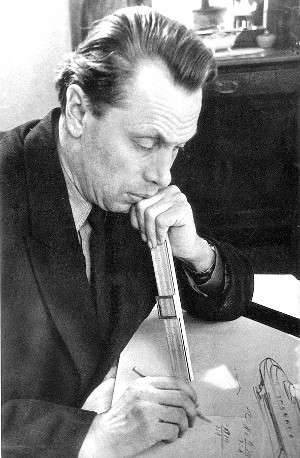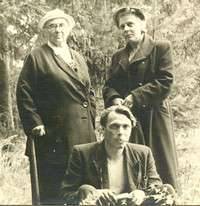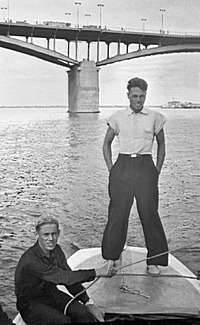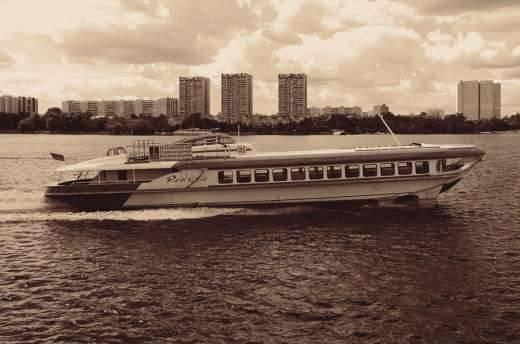Airplane plus ship. Part of 1
 The birth of a new always happens with difficulties. Some of the designers were lucky to be born in the Soviet era, when the state gave the last opportunity to create new equipment. Rostislav Alekseev was lucky. Despite the wartime, he was able to work on the creation of his technology, ahead of time.
The birth of a new always happens with difficulties. Some of the designers were lucky to be born in the Soviet era, when the state gave the last opportunity to create new equipment. Rostislav Alekseev was lucky. Despite the wartime, he was able to work on the creation of his technology, ahead of time.This happened more than seventy-five years ago, an event at that time little known and noted only in the records of the academic council of the Gorky Polytechnic Institute. In the fall of 1941, a student diplomat Rostislav Alekseev defended his project of a sea ship on hydrofoils.
The diploma projects were defended in one of the large audiences of the shipbuilding department. It was a closed defense: the graduate student was getting ready to talk about his idea of creating a high-speed boat for the needs of the Navy. In the conditions of war it was a state task.
It was a clear day, and the rays of the sun generously flowed into the audience through wide windows. A large red building of the Polytechnic Institute towered on the embankment of the Volga.
Rostislav Alekseev hung out drawings of his project on six boards. They stood in a semicircle around the examiners table.
The comrades knew that whatever he undertook, he did everything enthusiastically and seriously. Youthfulness is sometimes prone to levity, a quick change of desires and impulses. Rostislav did not recognize unfinished business, actions not thought out in strict logical sequence. He was stubborn, if not stubborn. Carried away, he gave himself up to the dream with all his soul. It began in childhood. Rostislav was born in Novozybkov, in the Oryol region, a year before the 1917 revolution of the year. His father, Yevgeny Kuzmich Alekseev, was a scientist, an expert in the field of agriculture. The man himself tireless energy and efficiency, he and his sons brought up in the spirit of strict discipline and unbending loyalty once and for all chosen in life business. From his father Rostislav contracted a thirst for scientific achievement.
When the boy was eleven years old, a misfortune happened in the Alekseevs family. Yevgeny Kuzmich, corresponding member of the Belarusian Academy of Sciences, was denounced to Siberia. But even there, in Siberia, as soon as the opportunity arose, Yevgeny Kuzmich began working at an experimental agricultural station - engaged in the cultivation of hemp.
Little Rostislav, in those years, lived with his mains in the Urals, went to school and early began his career (he worked as a radio mechanic at one of the defense enterprises of Nizhny Tagil).
 Soon Rostislav moved to Gorky, and here in 1933 he entered the faculty of workers, and then in 1935, he became a student of the famous Gorky Polytechnic Institute.
Soon Rostislav moved to Gorky, and here in 1933 he entered the faculty of workers, and then in 1935, he became a student of the famous Gorky Polytechnic Institute. Turn over the pages of his study. Finally a diploma defense.
To the left of Alekseev, a general view of a new sea hydrofoil hung on a board, rather a drawing than a drawing. A white torpedo-shaped ship with a streamlined shape, like a giant plane with severed wings, flew across the turbulent expanse of water. The student’s diploma project was inspired by a bold dream.
- Theoretically, winged ships can move at speeds of up to two hundred kilometers per hour. For water transport, these numbers sound fantastic so far, ”said graduate Alekseev.
He went from one drawing to another. He spoke about the constructive principles of the new ship, about the difficulties of its creation, about the theory of motion on the wings, developed only in the most general principles and waiting for new researchers.
The plane flies in the airspace, and the ship on the wings moves on the verge of two spheres: water and air. This is the source of all the difficulties associated with the new principle of motion. Wing lift depends on the speed of movement. Only at a certain speed, this force is equal to the weight of the vessel. The speed increases - and the lifting force tends to bring the wings to the surface of the water. And then the lifting force decreases sharply, and the wings fall deep into the water.
The ship is difficult to move with a pre-set speed. The ship will fall into the water and jump out of it, like a giant fish. So, it is necessary to warn the regulation of the lifting force of the wings. This is where a new complex knot of theoretical, experimental and constructive problems arises.
The questions asked by Alekseev were full of interest in the remarkable work, the new prospects in shipbuilding, which could not leave anyone indifferent.
“Are these your wings a variation of a known planing method?” - asked him.
“No, one side of the gliding plate is working, the underwater side has two,” answered Alekseev. - The bottom of the body of the hydrofoil is such a plate, but there the nature of the lift is different.
So there was this not quite usual defense of a student thesis project. The examination committee unanimously recognized the value and deep character of the research work done by the student. His diploma could be equated to the master's thesis.
So what is next? There was a war! From the institute Alekseev came to work at the Sormovsky plant. The forty-first year ended. The situation on the fronts was serious. Heavy. The young engineer was appointed to the workshop as the controller for the manufacture tanks.
Now he did not go home every day, he was on duty at the control point for fifteen to eighteen hours. It seemed, where was there to think about the project of winged ships! However, having seized the free minute, the engineer sat down somewhere in a quiet corner and, overcoming fatigue, which at times knocked him down, drew something, drew on pieces of paper.
No, he did not forget about his project.
Time passed, and he was transferred to the design bureau of the plant. Alekseeva summoned to himself the chief designer of the plant Vladimir Vladimirovich Krylov.
- I heard you have an interesting graduation project? - he asked.
- Yes, the idea of a ship on hydrofoils. But now everything has stopped. War!
- Still, let's try this: every day for two hours I will exempt you from the current work in the department. Think of your project. This is not enough, but is no longer in my power, ”said Krylov.
Six months later, the chief designer gave the young engineer the opportunity to fully surrender to the project and allowed him to make a self-propelled model for the experiments. Moreover, Krylov sent two more apprentices and appended student Leonid Popov to this small research group.
В stories winged ships began a period that Rostislav Evgenievich later called the "booth period on pontoons."
 This small wooden booth with slots in the walls, swaying on the pontoons, was their island. In winter, there was an iron stove in the booth, the air above the designers' heads was heated almost to forty degrees, and at the feet the temperature was below zero. At first they drew in quilted jackets and mittens, and then, warming up, took them off.
This small wooden booth with slots in the walls, swaying on the pontoons, was their island. In winter, there was an iron stove in the booth, the air above the designers' heads was heated almost to forty degrees, and at the feet the temperature was below zero. At first they drew in quilted jackets and mittens, and then, warming up, took them off.In the summer it was stuffy and crowded. The booth became a floating workshop, they wanted to make it also home. Alekseev wanted to put a bed here, but she didn’t fit between the benches and details.
The plant gave him the opportunity to experiment. What could answer? Only work, tireless and selfless. Leonid Popov, who shared all of Alexeyev’s dreams, became his right hand.
The first model was created. Alekseev himself found the motor to it at the dump of the broken engines and, along with Popov, dragged it onto the bank on the sled.
Motor went over and repaired. Alekseev was a carpenter, mechanic, and mechanic these days — he could do everything.
The war continued, the streets of Sormovo dug caterpillars of tanks, the plant strained its forces to the limit, carrying out orders of the front. And here, to the surprise of some people, four enthusiasts were busy with some strange model and project, almost fantastic.
But the two-seater self-propelled model was ready. Crane moved it and put it in the water. At first, something strange happened: the model was swimming, all the while leaning to its side. Alekseev moved it to another place, but the model immediately tilted again. She was leaning toward the water all the time, seemingly ready to roll over.
Of course, this failure in the very first steps spoiled the mood for both the designers and the audience. Where is there to wait for the flight on the wings, when the model could not lie on the water correctly! Alekseev walked along the bank angry and gloomy. The test model failed.
Only a few hours later he realized that the steel wings were hollow, and there was air in them. When he was released, the model straightened, but it was too late to begin the tests.
The next morning, the engine did not start for a long time. Finally he earned. Popov was late for the beach, Alexeyev was busy with the model. While he was going to untie the model, the clutch itself turned on, and the small boat on the wings started to float.
A few seconds of delay, and the model, having picked up speed, would have gone to the expanse of the Volga, maybe it flew into some ship and rammed the board.
Alekseev thought only for a moment. Pushing sharply off his feet, he jumped onto the long narrow hull of a small boat. Barely managed to catch on the stern. Alekseev, half immersed in the cold spring water, tried to climb the hull of the boat, to get to the motor.
All this cost him desperate efforts. The model's nose had already begun to bully upwards, a wing appeared from the water, but at that moment Alekseev managed to shut off the engine. All wet, frozen, tired, he led the model to the booth on the pontoons.
Trials began only at noon. On the boat were Alekseev and Popov. Slowly they moved away from the booth, anxiously glancing at the motor, gradually adding momentum, and so the model stepped onto the wings. Every minute the speed increased: fifty, sixty, seventy kilometers per hour! Oblong, sharp as a knife, an unusual boat, catching up and ahead of the ships, rapidly flew along the Volga.
For several days, Alekseev and Popov made trial runs, tested seaworthiness, measuring the required engine power at various speeds.
The results were very encouraging.
These days, at the request of Alekseev himself, a representative of a reputable scientific institution arrived at the plant. He got acquainted with the project of a winged boat, looked at all the drawings, watched the model move along the Volga. With awe and impatience, the young designers of his assessment, his conclusions, largely deciding the fate of the project, were waiting.
“I watched the model with curiosity,” the scientist admitted. “But from a double model to a large ship, the distance is huge.” You, comrades, do not clearly imagine what you have threatened. And in our scientific institution, many were engaged in this idea. Nothing happened. And then the plant, the war and some kind of booth on the pontoons! Should you waste your energy on this? Listen, friends, to our sad experience.
Despite this statement of a scholar, Alexeyev’s work was highly appreciated by the Navy services, but he didn’t manage to create his fighting boats with the highest speed until the end of the war. In 1951, for his work, he received the Stalin Prize of the second degree.
Not immediately after the successful tests of the first model, Alekseev had the opportunity to begin building such a large civilian vessel as the “Rocket”. Years passed, new models were built, new calculations were made, experiments were repeated. Alekseeva's group fought hard for the recognition of their project. Actually, no one objected to the essence of the idea itself. But the designers sent their projects to many scientific institutions and received in response almost identical letters: the authors of the letters had a lack of confidence in the schemes and calculations of the Sormovsky designers.
"In the way of practical application of the principle of the movement of a hydrofoil ship, there are serious difficulties that have not yet been overcome," one reputable reviewer warned.
“It is necessary to study a number of practical issues, and before that it is impossible to talk about it in that volume, as Comrade Alekseev does,” other scientific comrades wrote in the recall.
"In terms of constructive Alekseev also has no advantages over the previously proposed structures, the question of the strength of the hull has not been developed," they wrote from the next research institute.
Then a complicated, contradictory situation was created. They were demanded from the calculations and formulas, they gave them, but all the same, the reviewers did not believe in the reality of the creation of winged ships. “Confirm this with experience,” they demanded. And for the experience you need to build a ship in which they did not believe. How to get out of this vicious circle?
It is good that the designers were supported at the factory. They worked on its territory, the Sormovsky plant provided an experimental base - an experimental workshop.

At the beginning of 1956, an unusual meeting was held at the party committee of the Krasnoye Sormovo plant. In the conference room gathered engineers, shop managers, workers, plant managers. On the walls were drawings, diagrams, a general view of a cruise ship. It was a project no longer a model, not a boat, but a ship five meters in length 24 meters, with an engine of seven hundred horsepower, designed for 66 passengers, speed - 60 kilometers per hour.
This was, in fact, the second defense of the project, which received support. The party committee of the plant appealed to the Ministry of River fleet, and the experimental workshop received an order to create the first hydrofoil ship in our country. Thus began the birth of a cruise ship, which then became widely known under the name "Rocket."
To be continued ...
Information